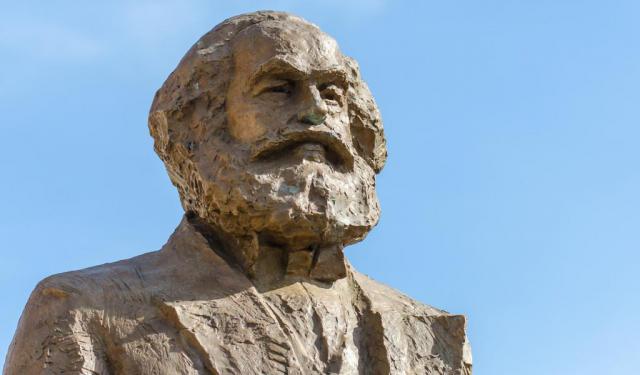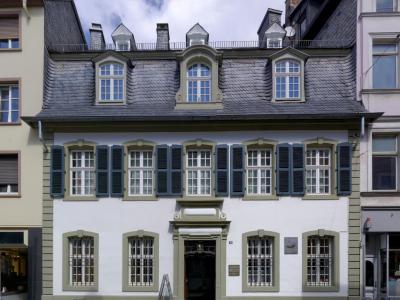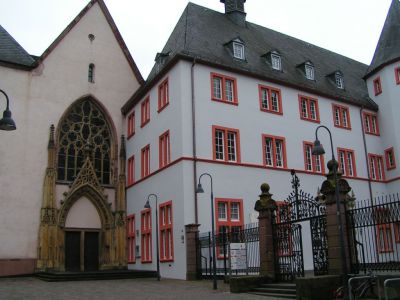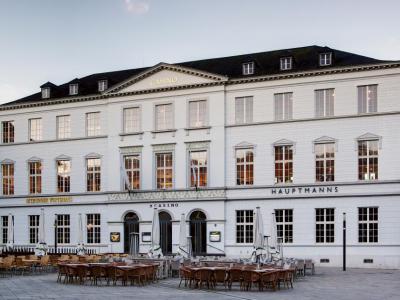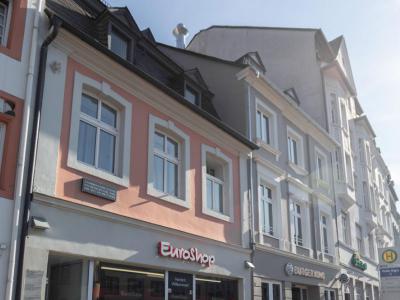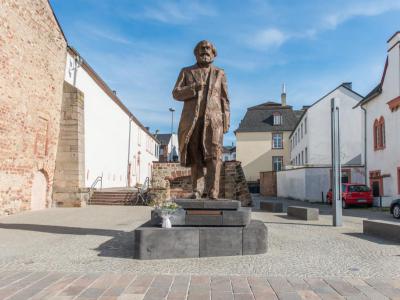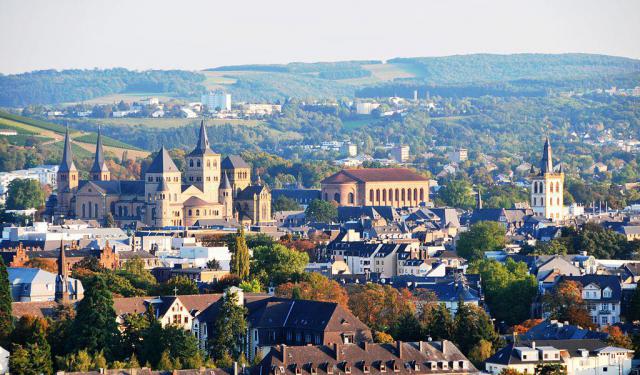In The Footsteps of Karl Marx (Self Guided), Trier
Apart from being a home to the largest number of Roman ruins outside Rome, Trier is also extremely popular with international tourists, especially those from China, as the hometown of Karl Marx.
Here, the father of socialism and one of the most important philosophers of the 19th century, who, as an adult, managed to change the course of the world's history, had spent the first 17 years of his life. For someone who had later changed cities like socks, this stint happened to be the second longest in any one place (in London Marx spent twice as long). Still, Trier was the city that had most shaped Marx's story.
Karl was born on May 5, 1818 in an 18th-century gabled house on Brückenstrasse, which is now the Karl Marx's House museum and the most important attraction for those keen on his legacy. The museum houses the famous bust of Marx sculpted by his great-grandson, the rare first edition of Das Kapital, Marx's seminal work, and other relics.
When the boy was just over a year and a half old, the Marxes moved to a different location, the pink house – presently known as Karl Marx Childhood Home – on Simeonstrasse, which is nowadays the main pedestrian street of the city. The family lived here until 1835, when Karl finished school.
Symbolically, Marx's wife, Jenny von Westphalen, also from Trier, used to live not far from his birthplace, just a few blocks away – on Neustrasse.
On the 200th anniversary of Marx's birth, the Chinese government added to the list of Marx-themed attractions in Trier a 5.5-meter statue, a nod to his birth date: 5.5.1818.
If you wish to follow in the footsteps of Marx in his hometown, take this self-guided tour. Whilst walking, make sure not to miss a pair of traffic lights, at the end of Fleischstrasse, with a cheerful bearded figure glowing not only with the classic revolutionary red, but also in green...;)
Here, the father of socialism and one of the most important philosophers of the 19th century, who, as an adult, managed to change the course of the world's history, had spent the first 17 years of his life. For someone who had later changed cities like socks, this stint happened to be the second longest in any one place (in London Marx spent twice as long). Still, Trier was the city that had most shaped Marx's story.
Karl was born on May 5, 1818 in an 18th-century gabled house on Brückenstrasse, which is now the Karl Marx's House museum and the most important attraction for those keen on his legacy. The museum houses the famous bust of Marx sculpted by his great-grandson, the rare first edition of Das Kapital, Marx's seminal work, and other relics.
When the boy was just over a year and a half old, the Marxes moved to a different location, the pink house – presently known as Karl Marx Childhood Home – on Simeonstrasse, which is nowadays the main pedestrian street of the city. The family lived here until 1835, when Karl finished school.
Symbolically, Marx's wife, Jenny von Westphalen, also from Trier, used to live not far from his birthplace, just a few blocks away – on Neustrasse.
On the 200th anniversary of Marx's birth, the Chinese government added to the list of Marx-themed attractions in Trier a 5.5-meter statue, a nod to his birth date: 5.5.1818.
If you wish to follow in the footsteps of Marx in his hometown, take this self-guided tour. Whilst walking, make sure not to miss a pair of traffic lights, at the end of Fleischstrasse, with a cheerful bearded figure glowing not only with the classic revolutionary red, but also in green...;)
How it works: Download the app "GPSmyCity: Walks in 1K+ Cities" from Apple App Store or Google Play Store to your mobile phone or tablet. The app turns your mobile device into a personal tour guide and its built-in GPS navigation functions guide you from one tour stop to next. The app works offline, so no data plan is needed when traveling abroad.
In The Footsteps of Karl Marx Map
Guide Name: In The Footsteps of Karl Marx
Guide Location: Germany » Trier (See other walking tours in Trier)
Guide Type: Self-guided Walking Tour (Sightseeing)
# of Attractions: 5
Tour Duration: 1 Hour(s)
Travel Distance: 1.6 Km or 1 Miles
Author: alice
Sight(s) Featured in This Guide:
Guide Location: Germany » Trier (See other walking tours in Trier)
Guide Type: Self-guided Walking Tour (Sightseeing)
# of Attractions: 5
Tour Duration: 1 Hour(s)
Travel Distance: 1.6 Km or 1 Miles
Author: alice
Sight(s) Featured in This Guide:
- Karl Marx House Museum
- Jesuit Church and Grammar School
- Französisches Casino (French Casino)
- Karl Marx Childhood Home
- Karl Marx Statue
1) Karl Marx House Museum
Influential philosopher Karl Marx was born in this house in 1818. He would become the father of Marxism, laying the groundwork for communism and socialism. The museum hosts exhibits about Karl Marx's life, works, and influence.
The house was originally built in 1727 and has been renovated many times over the years. The building has been dedicated to remembering Karl Marx since 1947. The exhibits were revamped in 2018 to celebrate the 200th anniversary of Karl Marx's birth. The exhibits include a Marx bust sculpted by Marx's great-grandson and a first edition print of the pivotal Das Kapital.
Visitors can explore Marx's origins, family life, career, and time in exile in London. The ground floor focuses on Marx's life and family. The top floor looks at his sociology, economics, journalism, and philosophy work. The final portion of the museum reviews Marx's influence on the labor movement and the influence Marx's ideas had on the world.
Visitors will find various historical documents, photographs, and Marx's favorite armchair on display. In addition to the exhibits, the house features a beautiful garden with several sculptures depicting Karl Marx.
The house was originally built in 1727 and has been renovated many times over the years. The building has been dedicated to remembering Karl Marx since 1947. The exhibits were revamped in 2018 to celebrate the 200th anniversary of Karl Marx's birth. The exhibits include a Marx bust sculpted by Marx's great-grandson and a first edition print of the pivotal Das Kapital.
Visitors can explore Marx's origins, family life, career, and time in exile in London. The ground floor focuses on Marx's life and family. The top floor looks at his sociology, economics, journalism, and philosophy work. The final portion of the museum reviews Marx's influence on the labor movement and the influence Marx's ideas had on the world.
Visitors will find various historical documents, photographs, and Marx's favorite armchair on display. In addition to the exhibits, the house features a beautiful garden with several sculptures depicting Karl Marx.
2) Jesuit Church and Grammar School
The Jesuit Church is a Gothic church that was constructed in 1228. It was used as a monastery church of the Franciscan order through 1570. It was then used by the Jesuit order for the next 300 years.
The church is one of the oldest preserved Franciscan churches in the country. The inner courtyard has a crypt that contains the bones of Friedrich Spee, a Jesuit priest and professor in early 17th century, who was best known as a forceful opponent of witch hunting. Spee's writings helped bring an end to the witch hunting practice in Germany.
A portion of the college was eventually turned into the Friedrich-Wilhelm Grammar School. Karl Marx attended the school for five years, from 1830 to 1835. Marx received a grade point average of 2.4 in his final exam at school with 1 being the highest grade.
Today, the Jesuit Church is used as the Diocesan Theological Seminary. The courtyard is sometimes used for concerts and special events.
The grounds are open from 9 AM to 5 PM daily. Admission to explore the grounds is free, but there is a charge when concerts are taking place. Those hoping to see the crypt must receive a key at the gate, which is only staffed Monday through Friday.
The church is one of the oldest preserved Franciscan churches in the country. The inner courtyard has a crypt that contains the bones of Friedrich Spee, a Jesuit priest and professor in early 17th century, who was best known as a forceful opponent of witch hunting. Spee's writings helped bring an end to the witch hunting practice in Germany.
A portion of the college was eventually turned into the Friedrich-Wilhelm Grammar School. Karl Marx attended the school for five years, from 1830 to 1835. Marx received a grade point average of 2.4 in his final exam at school with 1 being the highest grade.
Today, the Jesuit Church is used as the Diocesan Theological Seminary. The courtyard is sometimes used for concerts and special events.
The grounds are open from 9 AM to 5 PM daily. Admission to explore the grounds is free, but there is a charge when concerts are taking place. Those hoping to see the crypt must receive a key at the gate, which is only staffed Monday through Friday.
3) Französisches Casino (French Casino)
Franzosisches Casino, also known as the French Casino or Kasino Kornmarkt, is a classical building on Trier's Grain Market. It was built in 1825 by Johan Georg Wolff as a club house for the Trier Reading Society, founded in 1817. Members of the society included community leaders, the educated class and Prussian officers. Heinrich Marx, father of Karl Marx, was a prominent member of the Literary Casino Society.
It was at one of the Casino Society’s dancing balls where Karl Marx fell in love with the “Queen of the Ball”, Jenny von Westphalen. They were married in 1843 and moved to France the same year.
The building was heavily damaged during World War II in 1944. The only remaining components of the structure were the outer walls. It was rebuilt using the original design for its outer facade. The interior was fully remodeled, but an original spiral staircase was restored and put in place.
The building was restored after the World War II and served as a casino for the occupying French soldiers, which gave it its current name. It is now an event venue that serves as the location of cultural celebrations, parties, lectures, theatrical performances and concerts.
It was at one of the Casino Society’s dancing balls where Karl Marx fell in love with the “Queen of the Ball”, Jenny von Westphalen. They were married in 1843 and moved to France the same year.
The building was heavily damaged during World War II in 1944. The only remaining components of the structure were the outer walls. It was rebuilt using the original design for its outer facade. The interior was fully remodeled, but an original spiral staircase was restored and put in place.
The building was restored after the World War II and served as a casino for the occupying French soldiers, which gave it its current name. It is now an event venue that serves as the location of cultural celebrations, parties, lectures, theatrical performances and concerts.
4) Karl Marx Childhood Home
The Karl Marx Childhood Home is a significant landmark commemorating the formative years of the influential thinker. Originally purchased by Heinrich Marx, Karl’s father, on October 1, 1819, this small baroque building with its distinctive mansard roof cost 18,987 francs in installments. The Marx family moved here from Bruckengasse, and it was within these walls that Karl, along with his siblings Sophia, Hermann, Henriette, Louise, Emilie, and Caroline, spent much of their childhood. The children, including young Karl, were baptized as Protestants on August 26, 1824, in the house, marking a pivotal moment after Heinrich Marx's conversion to Protestantism, a decision driven by career advancement prospects.
Karl Marx lived in this house until he graduated from high school in the autumn of 1835, at which point he left Trier to pursue higher education. During these years, he walked daily along Simeon Street, which remains largely unchanged today, creating a tangible link to his past. This home was more than just a residence; it was a family center, a place where Karl’s early intellectual development was nurtured under his father’s guidance, who homeschooled him until he enrolled in a local grammar school in 1830.
Though Karl Marx eventually moved on, the Simeon Street house continued to play a role in his life. Following his doctorate in philosophy in 1841, he returned to Trier, reuniting with his family and spending time with his fiancée, Jenny von Westphalen. After Karl’s departure, the home stayed in the family until 1851-52, after which it was likely sold, and its interior underwent renovations, ultimately housing a shop on the ground floor. Today, only a commemorative plaque above the entrance pays tribute to Trier’s most famous son, keeping alive the memory of Karl Marx’s early years in this city.
Karl Marx lived in this house until he graduated from high school in the autumn of 1835, at which point he left Trier to pursue higher education. During these years, he walked daily along Simeon Street, which remains largely unchanged today, creating a tangible link to his past. This home was more than just a residence; it was a family center, a place where Karl’s early intellectual development was nurtured under his father’s guidance, who homeschooled him until he enrolled in a local grammar school in 1830.
Though Karl Marx eventually moved on, the Simeon Street house continued to play a role in his life. Following his doctorate in philosophy in 1841, he returned to Trier, reuniting with his family and spending time with his fiancée, Jenny von Westphalen. After Karl’s departure, the home stayed in the family until 1851-52, after which it was likely sold, and its interior underwent renovations, ultimately housing a shop on the ground floor. Today, only a commemorative plaque above the entrance pays tribute to Trier’s most famous son, keeping alive the memory of Karl Marx’s early years in this city.
5) Karl Marx Statue
The bronze statue of Karl Marx stands in the center of Trier. The statue was given to the city by the Chinese government. It was created by sculptor Wu Weishan. The statue itself is about 14 feet in height, but looms at more than 16-feet tall upon its large plinth.
It is located in a pedestrian square on the backside of the city museum and the Trier tourism and information center. The square provides plenty of room for viewing the statue. Those visiting the statue can read about Marx with a nearby placard that details information about the statue and Marx himself.
The Karl Marx statue was not erected without controversy. When it was added to the city in 2018, there were numerous protests from those who decry the abuses brought about by communism. There were also many who stated a gift should not be accepted from China, a country that is known for human rights abuses.
It is located in a pedestrian square on the backside of the city museum and the Trier tourism and information center. The square provides plenty of room for viewing the statue. Those visiting the statue can read about Marx with a nearby placard that details information about the statue and Marx himself.
The Karl Marx statue was not erected without controversy. When it was added to the city in 2018, there were numerous protests from those who decry the abuses brought about by communism. There were also many who stated a gift should not be accepted from China, a country that is known for human rights abuses.
Walking Tours in Trier, Germany
Create Your Own Walk in Trier
Creating your own self-guided walk in Trier is easy and fun. Choose the city attractions that you want to see and a walk route map will be created just for you. You can even set your hotel as the start point of the walk.
Trier's Roman Ruins Walking Tour
Nowadays it sounds a bit weird that a small German town of Trier, some 20-minute drive from the Luxembourg border, was once the capital of the mighty Western Roman Empire. Still, "the second Rome", as the emperor Diocletian used to call it, today fully lives up to its former status.
Founded in 15 BC by the Roman emperor Octavian Augustus, this oldest city in Germany is a home to the... view more
Tour Duration: 2 Hour(s)
Travel Distance: 4.4 Km or 2.7 Miles
Founded in 15 BC by the Roman emperor Octavian Augustus, this oldest city in Germany is a home to the... view more
Tour Duration: 2 Hour(s)
Travel Distance: 4.4 Km or 2.7 Miles
Trier Introduction Walking Tour
Trier is Germany’s oldest city and features beautiful Roman ruins, impressive medieval architecture, stunning churches, and fascinating museums.
While an inscription on the famous Red House states that the city was founded 1300 years before the Romans arrived, this has never been proven. The Celtics originally founded Trier during the fourth century BC. The Romans arrived in the first century... view more
Tour Duration: 2 Hour(s)
Travel Distance: 3.5 Km or 2.2 Miles
While an inscription on the famous Red House states that the city was founded 1300 years before the Romans arrived, this has never been proven. The Celtics originally founded Trier during the fourth century BC. The Romans arrived in the first century... view more
Tour Duration: 2 Hour(s)
Travel Distance: 3.5 Km or 2.2 Miles
The Most Popular Cities
/ view all
